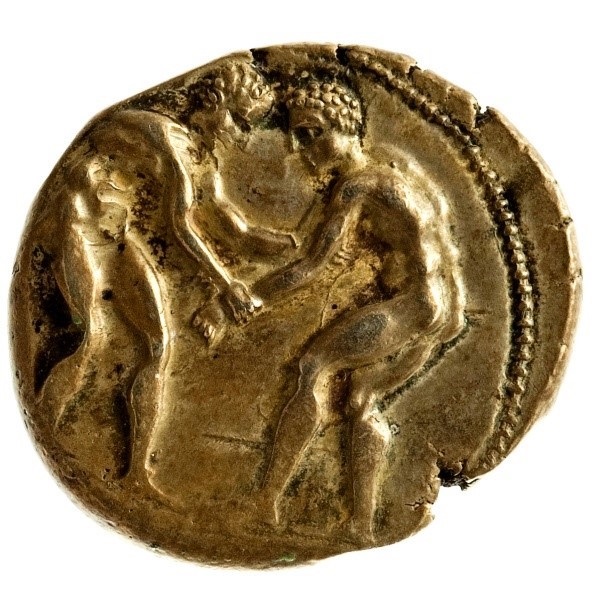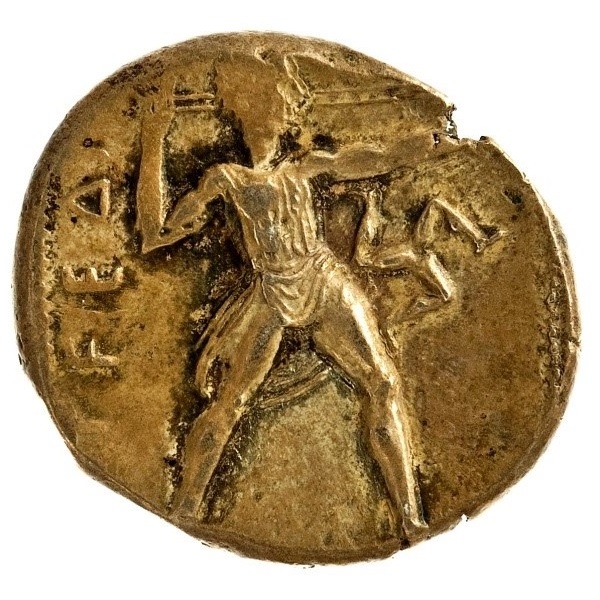Acquisition number: 1986.19
Obv.: Two naked wrestlers leaning forward and coming to grips by holding each other by the arms.
Rev.: Slinger advancing r. about to loose a slingshot; triskeles (three human legs joined at the top of the thighs in a wheel-pattern) to right; legend: ..ϜΕΔ.. part of the city name ΕΣΤϜΕΔΙΙΥΣ (the Pamphylian form of Aspendos?). The other characters are off the flan or not struck up.
Title: Stater of Aspendos, Pamphylia - 1986.19
Acquisition number: 1986.19
Author or editor: Douglas Kelly
Culture or period: Classical Greece.
Date: c. 400 - 300 BC.
Material: Metal - Silver
Object type: Coins - Greek
Dimensions: 23mm (w)
Origin region or location: Türkiye
Origin city: Aspendos.
Display case or on loan: 5
Keywords: Coin, Greek, Classical, stater, Aspendos, Pamphylia, Caria, Karia, triskeles, Belkis, theatre, Anatolia
Sylloge Nummorum Graecorum, France, Bibliothèque Nationale (Paris, Numismatica Ars Classica, 1983-), 243 - 5.
Classical Numismatic Group Auction 998511.
1986.19
Stater of Aspendos, Pamphylia
Silver, 10.90 g. 23 mm. c. 400-300 BC.
Obv.: Two naked wrestlers leaning forward and coming to grips by holding each other by the arms.
Rev.: Slinger advancing r. about to loose a slingshot; triskeles (three human legs joined at the top of the thighs in a wheel-pattern) to right; legend: ..ϜΕΔ.. part of the city name ΕΣΤϜΕΔΙΙΥΣ (the Pamphylian form of Aspendos?). The other characters are off the flan or not struck up.
Aspendos (modern Belkis) stood 13 km upstream on the river Eurymedon (the site of Kimon’s celebrated victory c. 468) on the south coast of Turkey, 47 km east from Antalya. The massive theatre at Aspendos of the second century AD, the finest surviving example of a Roman-style theatre from antiquity, is a good indication of the wealth and population of this region. It seated approximately 7,500.
At the beginning of the fourth century BC Aspendos, while retaining the same Persian weight-standard of the stater, made a radical change from the types of the coinage of the previous sixty years, which was something rarely done by a Greek city. The new coinage followed the regional preference for full-length figures rather than portrait-heads. The significance, however, of the motif of the two wrestlers remains elusive. The triskeles on the reverse was the civic badge of Aspendos. This old Indo-European symbol occurs elsewhere on Greek coins.
The Greek lettering that appears on the reverse is what remains of the name of the town, apparently a partly Hellenized spelling of a native Anatolian name. Like the other cities of this region of Pamphylia, Aspendos claimed a Hellenic pedigree going back to the heroic age. It is clear that the cities of Pamphylia had mixed populations of Greeks and various groups of Anatolians. What the proportions of each group were, and the rate at which the non-Greek population was Hellenized in language and culture, is not known.
Sylloge Nummorum Graecorum, France, Bibliothèque Nationale (Paris, Numismatica Ars Classica, 1983-), 243 - 5.
Classical Numismatic Group Auction 998511.

